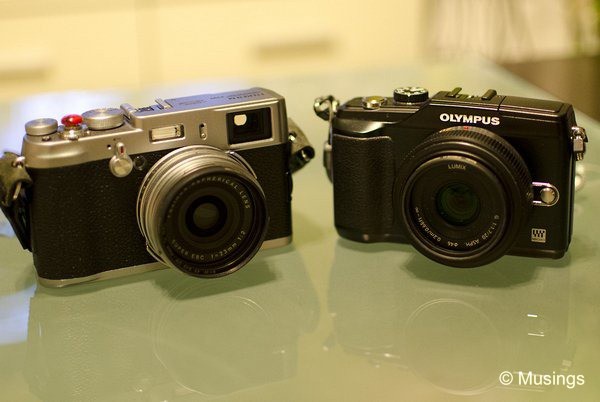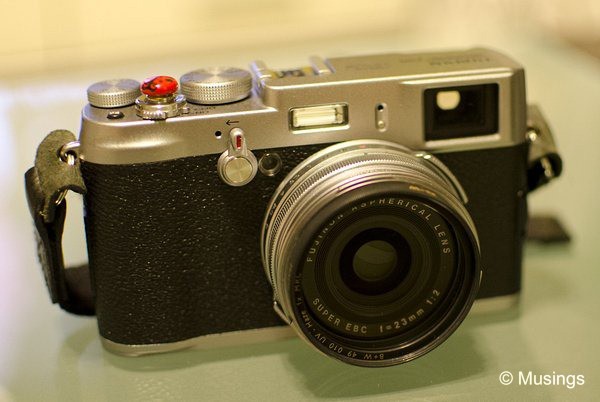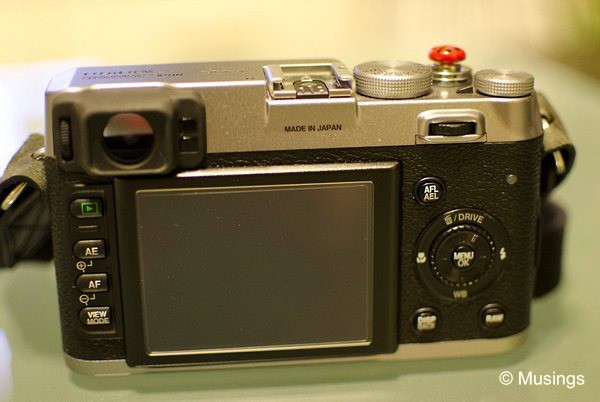5 Feb 2012: Decided to append more notes (it’s at the end of my post here) rather than write a new one. Original 2 Feb post starts below.=)
No it’s not my camera. I can only dream!

That student blog-stalker just picked up a Fujifilm X100, and knowing my interest in photographic toys, asked me to take it home for over the weekend to try it out (and most likely for me to salivate over too). So I gamely took up the offer, with his expectation that I’d blog about it right here. And to get it out of the way: this is a very amateur review.
The X100, pictured on the above next to my puny E-PL2, is a technological marvel. It combines very high build quality, rangefinder styling, and a comparatively large sensor to produce images that review sites all over have called superb. This post isn’t a review of the X100 of course since I’m not nearly ‘pro’ enough to write one. But it’s still some observations and notes on my experience handling it for the next couple of days and what I think at the end of it!

From picking-up the camera, there’s no mistaking the feeling that you’re not handling a piece of cheap plastic jammed with bargain bin electronics inside and Made in China. You’re handling a finely and lovingly crafted art piece, made with magnesium alloy, what seems like other assorted metals (the ISO and exposure compensation dials on top), with some inevitable plastic (e.g. the dials and buttons at the back of the camera). And Made in Japan even, as the serial plate at the bottom of the camera proudly states.

The optical viewfinder is a real pleasure to use too. It’s not through-the-lens (like a DSLR), and it – cutely – even shows the edge of the lens when you look through it! The frame outline, aperture, shuttle-speed and ISO are superimposed into your view too and it looks super high-tech.
Funnily though; the viewfinder doesn’t black out when the camera’s in OFF position nor if you’ve got the lens cap still on. And being the new user to the camera as I am, there were a couple of times while learning the device when I composed through the viewfinder, hit the shuttle release, and nothing happened – and only because the camera wasn’t switched on or that the front lens cap hadn’t been removed LOL.
I’ve only take a few pictures of Hannah the first evening, since we got home late all feeling rather sick (family virus) and didn’t have much time after dinner before we had to get started on her winding-down routine. So, after spending time figuring out how to even take a picture with the X100 – no taking pictures with the X100 isn’t so simple of just switching it ON, setting it to ‘Auto’ and then firing away – I only had time left for a few pictures. And here’s one:

And that’s a JPG straight out of the camera! No sharpening, no color correction etc. Just some very minor cropping (a small part of my foot was accidentally in it) and resizing to fit the blog post. And shot at f2, 1/60s, 2500 ISO. And the flash fired even straight ahead, but you couldn’t tell unless you stare longer than a few seconds. Long story short; image out of the box, noise control and center sharpness wise, it seems better than what my E-PL2/20mm f1.7 can muster.
More notes to come soon once I’ve had more time to tinker with it.=)
Update: Now that I’ve played with the X100 for a bit, I’ve come to my summary comment: it’s a great tool that produces stunning images, but for me to use it means I’ll have to make adjustments on the kind of photography I do these days. Spot focusing on the X100 is a little slow. And while it’s still faster than the rather slow AF on the Panasonic 20mm f1.7, the kit lens off the E-PL2 is a speed demon compared to this. This simply won’t do when I’m going to take pictures of a 2.5 year old girl who doesn’t remain still!
More seriously though is the minimum focusing distance of 80cm compared to the 20cm of the 20mm f1.7. The workaround, according to user forums, is to use macro mode – but I didn’t get round to trying that out.
The online forums and reviews have also pointed out a severe design issue with the rear command dial, and I couldn’t agree more. Specifically, the button depress of the dial’s OK button is so low that three quarters of the times the upwards arrow gets pressed instead of the OK button. It’s bad.
Recent comments